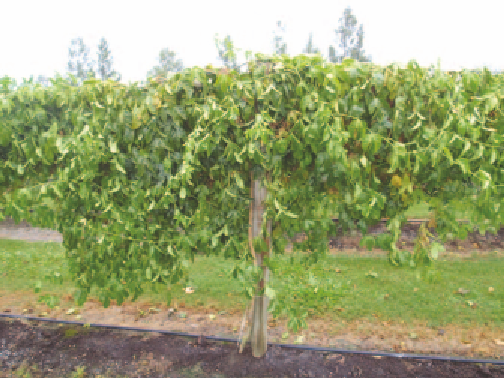Agriculture Reference
In-Depth Information
Fig 15.10 Necrosis of passionfruit leaves and fruit caused by
Phytophthora nicotianae
.
Fig 15.9 Passionfruit vines infected with Fusarium wilt caused
by
Fusarium oxysporum
f. sp.
passiflorae
.
Importance
Fusarium wilt was once a major disease of ungrafted
f.
edulis
in Queensland and New South Wales. It is now
adequately controlled by using resistant rootstocks
of f.
flavicarpa.
Passiflora caerulea, P. incarnata
and
P. herber tiana
are also resistant but are less suitable
as rootstocks.
Fruit: large, grey-green, water-soaked areas develop.
Infected fruit falls readily and, in wet weather, are covered
with white fungal growth.
Source of infection and spread
The pathogen is a soil inhabitant. Spores are initially
produced in wet soil beneath vines and splashed onto
stems, leaves and fruit near ground level. Further spread
occurs during wet, windy weather when spores formed on
infected leaves and fruit are blown through the canopy.
Management
•
Grow cultivars grafted to wilt-resistant seedlings of the
golden passionfruit (
Passifl ora edulis
f.
fl avicarpa
). For
seed production, golden passionfruit should be grown
in isolation to avoid crossing with lines susceptible to
Fusarium wilt. Several vines of this self-incompatible
cultivar are needed to encourage cross-pollination.
Ensure that the seedlings derived from an isolated
inbreeding population have a high level of resistance
to Fusarium .
PHYTOPHTHORA BLIGHT
■
Cause
The oomycete
Phytophthora nicotianae
.
Symptoms
Leaves: blackening and death of young tip growth occurs.
Large, water-soaked areas develop on leaves, which become
light tan in colour. Infected leaves fall readily and vines
may be defoliated.
Stems: diseased areas above the graft union are at first
purple and later turn brown. These may completely girdle
the stem causing wilting and collapse of the vine.
Fig 15.11 Passionfruit vines damaged by
Phytophthora nicotianae
.













